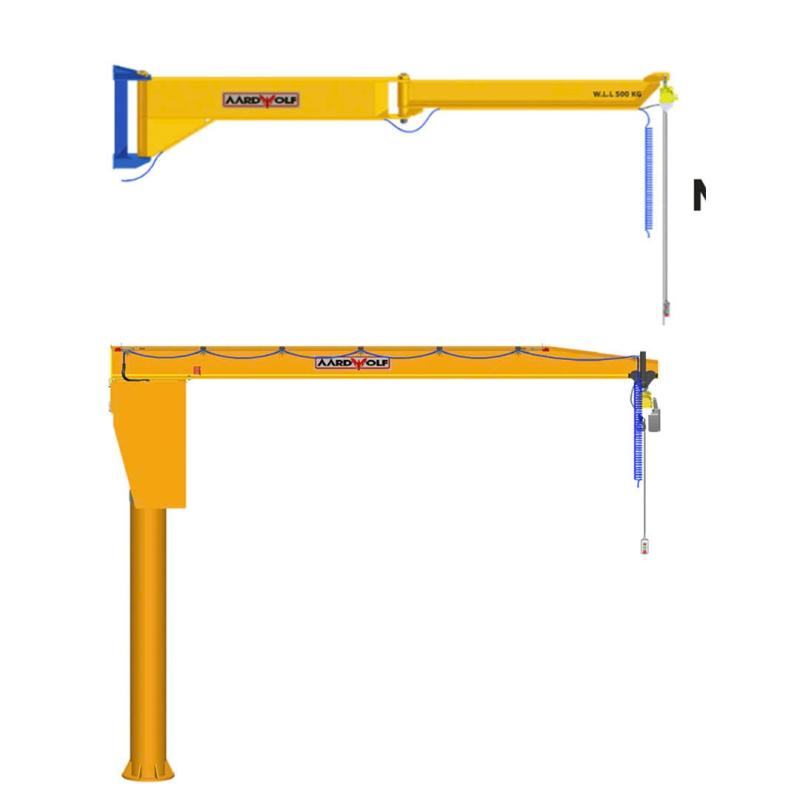



One of the most effective tools for localized lifting is the jib crane. From manufacturing floors to logistics warehouses, jib cranes offer versatile, space-efficient solutions that support repetitive lifting tasks with minimal operator strain.
If you're evaluating lifting solutions for your facility, this guide explores the technical and buying considerations to help you choose the right jib crane. We also include real-world use cases featuring Aardwolf products to illustrate best-fit applications.
Explore The Efficiency of Jib Cranes in warehouse for a full range of lifting solutions.
Jib cranes are a category of material handling equipment designed for lifting, moving, and lowering loads in a specific radius. Unlike overhead or gantry cranes, which serve larger operational areas, jib cranes focus on improving efficiency within individual workstations or zones.
They are ideal for:
Repetitive material transfer in work cells
Machine loading and unloading
Tool or mold handling in assembly stations
Ergonomic support in labor-intensive operations
Learn more about the types of cranes in How to handle Jib Cranes Installations.
Choosing the correct jib crane starts with understanding the configuration that best suits your layout, lifting needs, and space availability.
Freestanding jib cranes are mounted to a concrete foundation and offer full 360° rotation. These cranes are extremely versatile and do not rely on building structures for support.
Benefits:
Standalone base—no wall or ceiling requirements
Suitable for indoor and outdoor use
Can handle higher capacities
Ideal For: Warehouses, logistics centers, and fabrication plants with open floor space.
Wall-mounted jib cranes are fixed to a vertical wall or structural column, offering 180° to 200° rotation. This type is preferred in facilities with limited floor space.
Benefits:
No floor footprint required
Ideal for side-station operations
Cost-effective installation (if wall structure supports load)
Ideal For: Assembly lines, loading docks, fabrication areas.
Ceiling-mounted cranes are used when floor and wall options are unavailable or need to remain clear. They are installed on the roof trusses or ceiling beams of a facility.
Benefits:
Zero impact on usable floor area
Seamless overhead lifting
Ideal for tight or congested environments
Ideal For: High-traffic production zones, small workshops, labs.
Articulating jib cranes feature a two-arm pivot system, enabling movement around corners, pillars, or tight machinery layouts.
Benefits:
Exceptional maneuverability
Perfect for precision tasks
Easy to use in irregular workspaces
Ideal For: Automotive plants, electronics assembly, CNC stations.
Also referred to as column-mounted or over-braced jib cranes, these are installed on a concrete floor with a steel column support.
Benefits:
High load capacity
Excellent for centralized lifting
Supports consistent radius operation
Ideal For: Heavy manufacturing, tooling facilities, injection molding.
For differences among crane types, visit The difference between crane and jib cranes.
Evaluate the maximum weight your crane must handle. Consider not just the heaviest item, but also any tooling or grippers added to the lifting assembly.
A 360° rotating crane offers maximum coverage, but sometimes a limited arc (180°–200°) may better fit a workspace’s layout and safety parameters.
Does your facility have structural walls or ceiling beams strong enough for mounting? If not, a freestanding or pillar-mounted solution is ideal.
Measure your available space, check for overhead interference (pipes, lighting), and determine if articulating arms are needed for maneuverability.
A floor-mounted crane requires a reinforced concrete slab, typically at least 150 mm thick and properly rated for the crane’s load.
Check A useful key to apply jib cranes for installation guidance.
Product: Wall Mounted Jib Crane – 4m-250
Challenge: Handling large metal sheets without crowding the floor
Solution: Installed Aardwolf wall-mounted cranes to transfer material from racks to laser beds with 180° motion
Result: 30% reduction in material handling time and fewer lifting injuries
Product: Freestanding Jib Crane with custom boom
Challenge: Support for high-volume palletizing
Solution: A 5m arm with 360° rotation and electric chain hoist
Result: Increased throughput and eliminated need for structural reinforcement
Product: Articulated Jib Crane – Wall Mounted
Challenge: Navigating tight layouts for engine installation
Solution: Articulating design enabled flexible movements
Result: Workflow handled by one operator instead of two
Product: Pillar-Mounted Over-Braced Crane
Challenge: Mold changeovers in cramped central area
Solution: Crane placed centrally in the mold-change zone
Result: 40% reduction in tool swap times
Product: Manual Counterbalance Jib Crane
Challenge: Safely maneuvering heavy stone slabs
Solution: Portable counterbalance crane supported movement between stations
Result: Safer and more mobile operations
Always inspect concrete integrity before floor mounting
Use torque-tested anchors and follow manufacturer guidance
Conduct annual inspections and grease the pivot bearings
Replace worn wire rope or chains as per OEM schedules
Document and log every maintenance cycle
For more detailed guidance, see Installing wall-mounted jib cranes.
The right jib crane depends on your workspace, lifting needs, and material flow. Aardwolf offers a wide variety of models to match each facility’s unique requirements—from compact wall-mounted units to heavy-duty freestanding cranes.
Whether you're moving engine parts, metal sheets, molds, or granite slabs, a well-selected jib crane will reduce downtime, improve safety, and streamline your operations.
Start your search by reviewing The Efficiency of Jib Cranes in warehouse, and explore the full product line to find a solution tailored to your application.
References
1. How to operate a Jib Cranes safely
3. Over brace jib crane wall mounted
5. Is a Jib Crane a Gantry Crane
6. Articulated Jib Crane Wall Mounted
8. Manual Counterbalance Crane
10. Over Braced Jib Crane Column Mounted
11. Powered counterbalance Crane
Sign up to receive the latest info on new Aardwolf products, special offers and more.
By signing up you agree to receive emails from Aardwolf with news, special offers, promotions and other information. You can unsubscribe at any time.